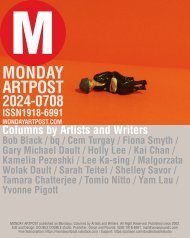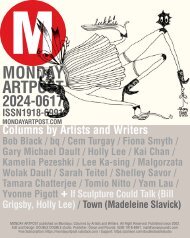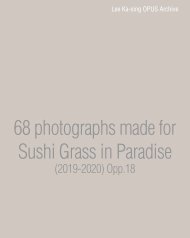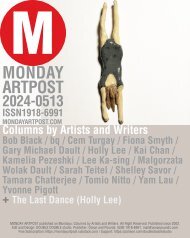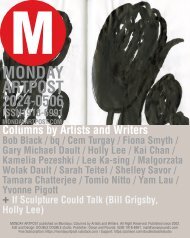You also want an ePaper? Increase the reach of your titles
YUMPU automatically turns print PDFs into web optimized ePapers that Google loves.
<strong>TERRAIN</strong>, <strong>nine</strong><br />
(photographs and haiku)
This is the ninth volume of <strong>TERRAIN</strong>,<br />
an ongoing collaboration between two artists,<br />
featuring Ka-sing’s photographs and<br />
Gary’s haiku in response.
Striplings<br />
wood branching out<br />
a touch of fabrication<br />
makes all trees kin
The Pointer<br />
A gnarled tree trunk<br />
witness to the pain of time<br />
points like Leonardo’s John the Baptist
Sweet Tree of Youth<br />
the tree remembers its nursuryhood<br />
when it was treeney treeney<br />
greeny*<br />
*Federico Garcia Lorca, “Treeney Treeney”<br />
in The Cricket Sings (New York: New Directions,<br />
1980).
Shapeshifter<br />
a fallen trunk<br />
once a proud backbone<br />
now a lizard, a praying mantis
The Sound of Silence<br />
a dry hippo<br />
opens its stygian jaws<br />
yawning for the lost river
Three-Way Split<br />
you can see where this<br />
was going: three minds<br />
born of a single thought
The Nautilus<br />
a miniature Leviathan<br />
plys the surly sea<br />
of leaves
Whole and Parts<br />
There is nothing more deft<br />
in Rodin: the slain wood<br />
pulls together with great subtlety
Sesame<br />
the tree’s sacred gate<br />
is not long open<br />
before filling with dry leaves
The Sylvan Smile<br />
the animal smile<br />
is everywhere<br />
for example in a cut tree
On Being Perhaps Too Associative<br />
It’s pleasurable to untether the mind<br />
and let it wander: I look at this and I see<br />
Hiroshi Teshigahara’s film, Woman in the Dunes*<br />
*Made in 1964 from Kobe Abe’s 1962 novel
Aurora Arborealis<br />
beyond any tree trunk<br />
a firmament-high screen<br />
flickers with humming lightshow
Grassy Knoll<br />
thin straw-like spears<br />
once home to throbbing chlorophyll<br />
fall across inert treewood
Trencherman<br />
this old deciduous mask<br />
its rictus smile<br />
like a battleground trench
Incision<br />
the drumhead stump<br />
compromised<br />
by a sharp bite of light
Very Like a Beaver<br />
Remember when Hamlet teases Polonius<br />
that clouds can look like creatures--a camel,<br />
a whale? Well, this trunk looks like a beaver.
Image Bank<br />
What comes unbidden to mind:<br />
scimitar, battle-axe, sling blade,<br />
halberd, cleaver
Tree Crier<br />
A sylvan discourse rises like a shout<br />
from the cut tree<br />
now a loudspeaker
TreePad<br />
the cut surface<br />
is now a blackboard<br />
with scratchy drawings
Well Enough Alone<br />
Unable to let things be:<br />
a trunk is the White Cliffs of Dover,<br />
a crocodile’s maw, a 1948 Buick’s grin
Deep Woods<br />
Is that a figure spelunking wood caves?<br />
I say it’s Jules Verne<br />
Voyaging to the Centre of the Earth
Speaking Parts<br />
the opulent stump<br />
its cushioned utterance<br />
a tear in its wooden flesh
UnRest<br />
dreams released from a felled tree:<br />
a dinosaur’s fallen head<br />
teeth still alive
Trunk of Ages<br />
coils of age<br />
one lying lifeline<br />
traversing the trunk’s open palm
Hit Man<br />
My friend tree<br />
I sawed you down*<br />
now I want to unplug the sun<br />
* These two lines are from American poet,<br />
Lorine Niedecker (1903-1970)
The Snout is Out<br />
a stump of trunk<br />
snouted like a pig<br />
surprised at its own strength
Wood, Waiting<br />
nothing is inert<br />
everything remembers new lives<br />
tree trunks posit leaves in the sky
Insect in Paradise<br />
labial limbs<br />
a modest tree<br />
with insistent dragonfly
Mack the Axe<br />
when the axe bites<br />
with its blade dear*<br />
the chips fall where they may<br />
*A variation on the Bertolt Brecht / Kurt Weill song,<br />
“Mack the Knife” from their 1928 musical play, The<br />
Threepenny Opera.
Muted<br />
Tom-toms in the hay<br />
sound beside its absorption<br />
specificity in the grass alas
Barbaric Yawp*<br />
the split opens the tree<br />
to trashy readings: the Pac-Man<br />
maw, the “Anguished Face” emoji<br />
*”I too am not a bit tamed, I too am untranslatable,<br />
I sound my barbaric yawp over the roofs of the world.”<br />
Walt Whitman, Song of Myself, 1892
Unsaved Remnant<br />
the anguish of the less than whole<br />
wood without the tree<br />
the anti-prosthesis, the not-belonging
Crater Violet*<br />
A foreskinned crater,<br />
the ghost<br />
of a wooden volcano<br />
* a deplorable but for me irresistible pun<br />
on “Prater Violet,” the title of Christopher<br />
Isherwood’s 1945 novel about filmmaking.
Let It Come Down*<br />
the armouring bark<br />
the exposed wood flesh<br />
the sky getting closer<br />
*The title of a 1952 novel by American writer<br />
and composer Paul Bowles (1910-1999)
A Tree by any other Name<br />
Our decisions deceive us:<br />
bench, bridge, highway, runway<br />
there’s always a fallen tree
Mind-Forg’d Manacles*<br />
though bound only by cast shadows,<br />
the cut tree cannot consider<br />
any further move<br />
*The phrase is from the poem, “London” by<br />
William Blake (in his Songs of Experience, 1794).
Unstoppable<br />
the mother ship is stilled<br />
but an upstart pod<br />
peels off on a new mission
Tensegrity*<br />
monumental trunk<br />
like a Rodin<br />
like an eagle with furled wings<br />
* Tensional integrity is a structural principle (much explored by<br />
Buckmininster Fuller) based on a system of isolated components<br />
under compression inside a network of continuous tension.
Time Immemorial<br />
The clock at the foot<br />
of the tree reads ten-ten<br />
and will proclaim it always
Tree Trash<br />
A hollow tree trunk<br />
an Edward Weston pepper<br />
but brimming with natural refuse
Unheard Music<br />
striations like the palm of your hand<br />
though a violin may form<br />
around that sounding rent
The Anti-Lifeline<br />
the tree’s fascia<br />
is smooth and unblemished<br />
except for its rictus crack
A Cold Bier<br />
a cut tree’s bier<br />
with mourning leaves<br />
recalling the old days of lift
“The soul of an ancient bell goes<br />
back to a young tree.” *<br />
the soul of an ancient tree<br />
searches for a second use:<br />
perhaps a bench.<br />
* Victor Segalen, Pictures (London: Quartet Books,<br />
1991), p. 11.
Starting Over<br />
the tree is sheared away<br />
the fresh trunk opens to the sun<br />
this time it will be a flower
Chip Ahoy<br />
a bright chip<br />
sprightly as a canary<br />
powers up the dead tree
Angle of Incident<br />
Forest Management<br />
supports a two-tier<br />
system of felling
One-Way Street<br />
wood goes round and round<br />
like cream in coffee<br />
inner vectors can’t stop the spin
A Note from the Teacher(s)<br />
This hieratic tree was felled<br />
a thousand years ago<br />
by space sailors--who left a message
The Unkindest Cut of All<br />
The cut tree<br />
forgives the saw*<br />
but remembers the severance<br />
* See poet William Blake’s “The cut worm forgives<br />
the plow” from his The Marriage of Heaven and Hell (1793)
Lee Ka-sing 李 家 昇<br />
Ka-sing grew up in Hong Kong and has been living in Toronto, Canada since 1997.<br />
He was the co-founder of DISLOCATION (1992, with Lau Ching-ping and Holly<br />
Lee). In 1995, Ka-sing and Holly founded OP Print Program, covering a crosssection<br />
with original prints produced by Hong Kong contemporary photographers<br />
in the <strong>nine</strong>ties. Lee Ka-sing was awarded “Artist of the Year” (1989) by the Hong<br />
Kong Artists’ Guild, and he received the Fellowship for Artistic Development<br />
(1999) presented by the Hong Kong Arts Development Council. Selected<br />
monographs include “Thirty-one Photographs” (1993, Photo Art), “Forty Poems,<br />
Photographs 1995-98” (1998, Ocean & Pounds, Hong Kong Arts Development<br />
Council Publication Grant), “The Language of Fruits and Vegetables” (2004, Hong<br />
Kong Heritage Museum), “De ci de là des choses” (2006, Editions You-Feng),<br />
and “Time Machine” (2021, with haiku by Gary Michael Dault). Recent sequential<br />
photo works released in book form include “CODA” (2020), “Diary of a Sunflower<br />
Book Two” (2022), “Songs from the Acid-free Paper Box” (2022), and others. Lee<br />
Ka-sing’s work is held in private and public collections, as well as in museums<br />
such as the Tokyo Metropolitan Museum of Photography, M+ Museum, Hong<br />
Kong Heritage Museum, and Hong Kong University of Science and Technology.<br />
Gary Michael Dault<br />
Having spent most of his professional life in Toronto, as a painter, university<br />
teacher and art critic (his visual arts column, Gallery-Going, ran in The Globe<br />
& Mail for fourteen years, a sojourn he now regards as essentially purgatorial),<br />
Gary Michael Dault lives with his wife, artist Malgorzata Wolak Dault and<br />
their seven cats, in a greatly cherished Victorian house (called Swan House<br />
because of the stained-glass swans bedecking it) in the town of Napanee in<br />
Eastern Ontario. Dault is the author of numerous magazine articles and gallery<br />
catalogues, as well as a dozen books about the visual arts. He has published<br />
ten volumes of poetry, and has written three television documentaries, all for<br />
the late Sir Peter Ustinov (the most ambitious of which was a 6-hour miniseries<br />
titled Peter Ustinov: Inside the Vatican). Dault has exhibited his own paintings<br />
many times, most recently at Verb Gallery in Kingston, Ontario. He has been<br />
contributing regularly to the online Monday ARTPOST for over a decade.



